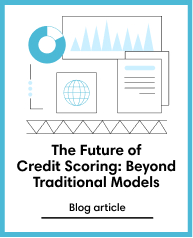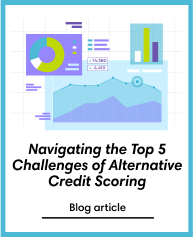Credit Scoring
Nov 18, 2025
AI Credit Scoring: A New Era for Fair and Accurate Lending
Subscribe to our newsletter
Traditional credit scoring systems, such as FICO, have notable limitations that often exclude individuals with limited or no credit history. These models primarily rely on historical data, which can be slow to update and may not fully capture a person’s true financial behaviour.
Consequently, many potential borrowers face significant barriers to accessing credit. The problem lies in the rigid nature of traditional scoring, which overlooks nuanced financial activities.
However, the emergence of machine learning (ML) and artificial intelligence (AI), where contextually necessary, is transforming credit assessment. These technologies offer a more dynamic, inclusive, and accurate evaluation of creditworthiness, addressing longstanding challenges.
This article examines how ML and AI are improving credit scoring, enabling fairer and more accurate lending decisions.
What is AI Credit Scoring?
AI credit scoring is an innovative financial tool that falls under the broader category of alternative credit scoring methods.
Unlike traditional models, which primarily rely on a limited set of criteria such as payment history, outstanding debt, and the length of credit history, AI credit scoring utilises ML algorithms to analyse vast and diverse datasets.
This enables a more comprehensive assessment of an individual’s financial behaviour and capacity to repay debt. The key advantage of AI models is their ability to identify complex, non-linear patterns and relationships across thousands of variables, often hidden from traditional models.
This enhances predictive accuracy and enables the inclusion of individuals with limited or non-traditional credit histories. As a result, AI credit scoring offers a more dynamic, personalised, and fairer approach to evaluating creditworthiness, effectively addressing the key limitations of traditional methods and fostering financial inclusion.
How AI Credit Scoring Works
AI credit scoring technology utilises behavioural metadata from mobile devices and web interactions to assess credit risk, detect fraud, and generate marketing insights, all while strictly respecting user privacy.
Software development kits (SDKs) and application programming interfaces (APIs) collect anonymised data such as app usage, device settings, typing speed, gesture patterns, and user interface interactions, without accessing any personal or sensitive information.
This privacy-by-design approach ensures compliance with global data regulations. The gathered behavioural patterns are processed by proprietary ML models that analyse complex signals to produce predictive scores and granular insights.
This method enhances predictive accuracy beyond traditional credit scoring by detecting subtle behaviours linked to financial reliability. The entire process is scalable and secure, enabling lenders to expand financial inclusion by reliably assessing credit risk among underserved populations who lack conventional credit histories.
The Advantages of AI in Credit Assessment
AI technology is transforming credit assessment by introducing capabilities that surpass traditional methods. This section explores how AI enhances accuracy, inclusivity, speed, and fraud detection in lending processes.
Superior Accuracy and Predictive Power
AI leverages ML algorithms to analyse vast amounts of data, identifying complex patterns that traditional models cannot. This results in significantly improved accuracy in predicting a borrower’s ability to repay, reducing default rates and enabling better lending decisions.
Improved Financial Inclusion
By incorporating alternative data sources beyond traditional credit history, AI credit scoring enables the inclusion of individuals with limited or no credit records. This broadens access to credit for underserved populations, promoting fairness and expanding opportunities for financial participation.
Unmatched Speed and Efficiency
AI systems process data in real time, enabling rapid credit assessments. This speed reduces wait times for loan approvals and lowers operational costs for lenders, making credit decisions faster and more streamlined than those made through traditional methods.
Proactive and Efficient Fraud Detection
AI models detect subtle and complex behavioural patterns to identify fraudulent activities more effectively. This proactive approach helps protect lenders and consumers by preventing fraud before it causes significant financial damage.
Navigating the Hurdles: Transparency and Fairness in AI Models
Addressing the "Black Box" Problem
The challenge of model interpretability is a critical hurdle in AI credit scoring. This obstacle is non-negotiable because regulatory scrutiny insists that credit risk decisions be accurate, fair, explainable, and defensible.
Financial institutions must comply with evolving global regulations, such as the Digital Operational Resilience Act (DORA) and upcoming frameworks, including the Financial Data Access regulation (FIDA) and the Payment Services Directive 3 (PSD3).
These impose stringent rules on the usage of alternative data, including mandatory third-party oversight and expanded data-sharing requirements.
Furthermore, recent policy changes by Google limit personal loan applications from accessing sensitive device data, such as photos, contacts, and location, directly restricting the data sources available for credit scoring.
These regulatory and policy shifts necessitate a transparent AI-driven credit risk assessment framework. Explainable AI (XAI) emerges as the solution, transforming risk evaluation from a complex and opaque process into one that is ethical, interpretable, and justifiable—ensuring compliance, building trust, and fostering fairness in lending decisions.
The Solution: Explainable AI (XAI)
Explainable AI (XAI) is a solution to the transparency and fairness challenges in AI credit scoring, as it opens up the model’s decision-making process for scrutiny and understanding.
XAI provides clear insights into how ML algorithms arrive at credit decisions by explaining the influence of specific data points on these decisions. This increased interpretability is crucial for meeting regulatory demands that credit risk decisions be accurate, fair, and justifiable.
By revealing the logical flow behind predictions, XAI ensures that decisions are ethical and defends them against scrutiny from regulators and consumers. It also helps lenders identify and mitigate potential biases in AI models.
Ultimately, the use of XAI builds trust in AI-driven credit assessment, improves compliance with evolving regulations, and promotes fairness in lending by making the technology’s workings accessible and transparent to all stakeholders.
Mitigating Bias
Mitigating bias in AI credit scoring is essential for ensuring fairness and equity in lending decisions. One practical approach is using diverse and representative training data that avoids reinforcing existing societal biases.
Fairness-aware algorithms and bias detection tools help monitor and correct disparities across demographic groups. Regular audits of AI models are conducted to identify and address potential biases, ensuring continuous improvement and refinement of these models.
Transparency and explainability further support the detection and mitigation of discriminatory outcomes by making decision processes understandable.
Implementation Checklist
- Data Readiness
Assess alternative data sources for quality, relevance, and compliance with user consent requirements.
- Model Development
Build baseline models; conduct explainability and fairness testing to ensure transparency and equity.
- Tech Stack
Establish data pipelines, Continuous Integration (CI) for machine learning, and real-time scoring endpoints.
- Ops & Governance
Monitor system performance, schedule periodic retraining, maintain audit trails, and comprehensive documentation.
- Quick Timeline + Resources Needs
Define a clear project timeline and allocate roles, including data engineers, data scientists, compliance officers, and ML engineers.
Step into advanced credit risk management with Credolab
Credolab’s unique selling proposition (USP) is its ability to leverage real-time scores and insights generated from proprietary device and behavioural metadata.
As a data and analytics platform, Credolab provides predictive insights and scores designed to enhance credit risk assessment, fraud prevention, and marketing strategies.
Its solutions empower clients to make improved decisions at every customer interaction point—whether during application, registration, onboarding, account login, or marketing communication.
Credolab’s technology is powered by privacy-consented, anonymised behavioural and device metadata, analysed using advanced ML algorithms across more than 80,000 data points. These insights and predictive scores are delivered through a unified API for seamless integration.
The key benefits include enhanced credit scoring with more accurate alternative risk scores, resulting in higher approval rates and a reduced cost of risk. In fraud management, Credolab helps detect fraudulent applications and synthetic identities, mitigating losses.
For marketing, it improves lead generation, optimises conversions, and boosts campaign ROI. The emphasis is always on predictive power, with financial inclusion as a secondary, yet significant, advantage.
Conclusion: Embracing a Fairer Financial Future
AI credit scoring is more than just an incremental improvement; it represents a paradigm shift in the financial services industry.
By leveraging advanced ML algorithms and vast, diverse datasets, AI systems deliver greater accuracy, speed, and fairness in assessing credit risk. This evolution enables lenders to make more informed, faster decisions while mitigating the bias inherent in traditional models.
The increased predictive power of AI transforms risk assessment into an inclusive, real-time process that better reflects an individual’s true financial behaviour.
The primary benefit of this technology is the creation of a fairer and more inclusive financial ecosystem. By incorporating alternative data and evaluating borrowers beyond traditional credit histories, AI-driven credit scoring opens access to credit for millions who were previously excluded.
This new approach fosters economic opportunity and broadens participation in the credit industry, supporting a more equitable financial future for all stakeholders.
FAQs
What specific machine learning models are typically used in AI credit scoring?
Commonly used models include logistic regression, decision trees, random forests, support vector machines, and deep neural networks. These models analyse traditional and alternative data to identify patterns that predict credit risk more accurately than conventional methods.
What is the difference between predictive AI and Generative AI in credit risk?
Predictive AI forecasts credit outcomes using historical and real-time data to estimate borrower risk, while Generative AI creates new data or content. Predictive AI is widely applied in credit risk assessment, while Generative AI is primarily used for data augmentation or simulation.
How does AI actually determine a credit score?
AI collects traditional and alternative data, cleans and processes it, then applies ML models trained on past repayments to predict the likelihood of default. It outputs a score reflecting creditworthiness based on complex behavioural patterns.
Can I use AI to improve my personal credit score?
Yes. AI-powered tools analyse your credit profile, identify errors, simulate the effects of financial actions, and offer personalised advice, helping you make informed decisions to improve your credit standing.
What is a credit AI score?
A credit AI score is a numeric estimate of creditworthiness generated by ML models that analyse extensive data points—including behavioural and device metadata—providing a more accurate risk assessment than traditional scores.
What is a good AI credit score?
A good AI credit score indicates low credit risk, generally aligning with traditional high credit scores (e.g., above 700). Such scores indicate strong repayment prospects and more favourable loan terms.
What Types of AI Models Are Used in Credit Scoring?
Supervised learning models (e.g., logistic regression, decision trees), unsupervised learning (clustering, anomaly detection), and hybrid models combining these approaches are used to improve accuracy and interpretability.
How Does AI Impact Fair Lending Practices?
AI can reduce bias by incorporating diverse data and detecting discriminatory patterns, promoting fairness. However, ongoing monitoring is essential to prevent the perpetuation of bias and ensure compliance with anti-discrimination laws.
What Are the Main Opportunities and Challenges for AI in the Credit Industry?
Opportunities include improved predictive accuracy, faster decisions, and financial inclusion. Challenges revolve around data privacy, model explainability, bias mitigation, and regulatory compliance to maintain ethical lending practices.





